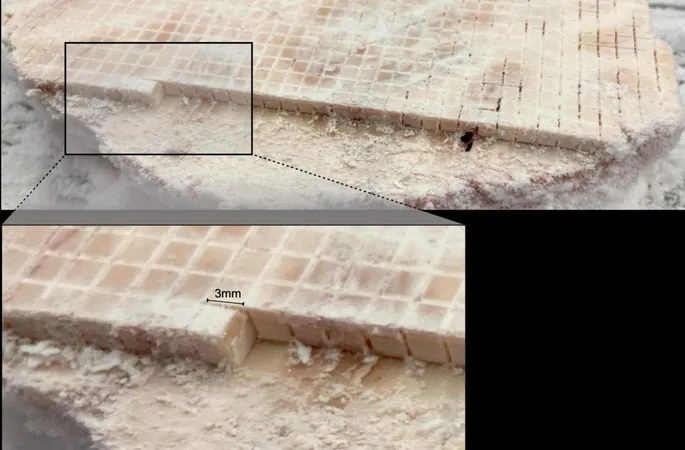
Groundbreaking MitoBrainMap Unveils Link Between Brain Energy Supply and Cognition
2025-03-26
Author: Sarah
Introduction
Every activity of the brain—from the intricate processes of storing memories to interpreting sensory information and regulating emotions—relies on energy produced by tiny cellular organelles known as mitochondria. Despite their crucial role, the understanding of the distribution and diversity of mitochondria within the brain has been surprisingly limited. This gap raises several vital questions: How many mitochondria inhabit our brains? Are they distributed uniformly? Do variations in these energy-providing structures influence mood, cognition, and the emergence of neurological and psychiatric disorders?
Creating the Atlas
In a pioneering effort to address these questions, researchers from Columbia University have introduced MitoBrainMap, the world’s first atlas mapping the energy powerhouse of the brain.
According to Martin Picard, the study's lead researcher and associate professor of behavioral medicine, "There's an emerging notion that energy is really important to health. But we currently lack a comprehensive way to assess bioenergetics across the human brain.”
A significant challenge in mapping the brain's energy landscape is the “scale gap” between microscopic examinations of mitochondria and broader neuroimaging studies like MRI scans. To bridge this divide, the research team obtained a section of a frozen human brain and meticulously cut it into 703 cubes, each measuring 3x3x3 mm—a size compatible with neuroimaging resolution.
By analyzing mitochondrial density and energy transformation capacity within each cube, researchers created an extensive energy map of the brain slice. Advanced computational modeling was subsequently employed to extrapolate these findings across the entire brain, avoiding the painstaking process of analyzing each of the brain’s approximately 50,000 voxels individually.
Revolutionary Findings
The research revealed significant differences in mitochondria not only between various cell types but also across different brain regions. "These differences are astonishing," stated Anna Monzel, a computational research scientist involved in the study. "All mitochondria descend from a common 'mother' pool during development but subsequently specialize based on energy demands specific to different cell types."
Interestingly, the study showed that newer brain regions—those that set humans apart from other species—boasted a higher density of mitochondria that are specialized for efficient energy production, aligning with the elevated energetic demands of these areas when compared to more ancient brain regions.
Looking Ahead
As research continues, further validation of MitoBrainMap is essential. This model could potentially facilitate the estimation of mitochondrial functional properties in a live brain using standard MRI scans, representing the first non-invasive approach to explore mitochondrial bioenergetics in human brains.
Such advancements would allow researchers to delve into how mitochondrial function correlates with brain activity during various states—cognitive tasks, developmental changes, diseases, or psychological conditions.
MitoBrainMap is just the initial version of exploring the brain's energy framework. Researchers are currently analyzing nine different brain regions across approximately 500 individuals, aiming to enhance the accuracy of the map and better understand mitochondrial distribution and specialization.
Picard emphasizes the integral role of energy in the realm of biomedicine, stating, "If you think of health as energy, it inspires you to ask different questions. How much energy is needed for brain healing? Does our diet influence mitochondrial function? Can energy constraints affect normal brain operation or contribute to conditions like Alzheimer’s? MitoBrainMap v1.0 marks a crucial stride in unpacking the energetic dynamics of the brain and the rich experiences it encompasses."
Conclusion
Stay tuned as scientists delve deeper into the world of mitochondrial bioenergetics, potentially unearthing groundbreaking insights that could transform our approaches to brain health and the understanding of cognitive processes.




 Brasil (PT)
Brasil (PT)
 Canada (EN)
Canada (EN)
 Chile (ES)
Chile (ES)
 Česko (CS)
Česko (CS)
 대한민국 (KO)
대한민국 (KO)
 España (ES)
España (ES)
 France (FR)
France (FR)
 Hong Kong (EN)
Hong Kong (EN)
 Italia (IT)
Italia (IT)
 日本 (JA)
日本 (JA)
 Magyarország (HU)
Magyarország (HU)
 Norge (NO)
Norge (NO)
 Polska (PL)
Polska (PL)
 Schweiz (DE)
Schweiz (DE)
 Singapore (EN)
Singapore (EN)
 Sverige (SV)
Sverige (SV)
 Suomi (FI)
Suomi (FI)
 Türkiye (TR)
Türkiye (TR)
 الإمارات العربية المتحدة (AR)
الإمارات العربية المتحدة (AR)